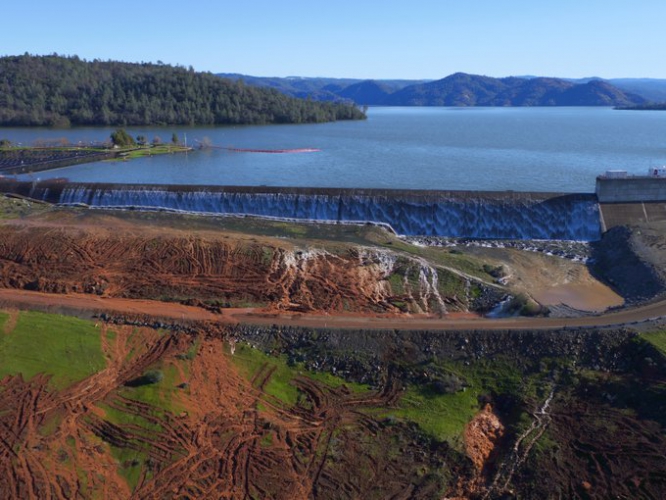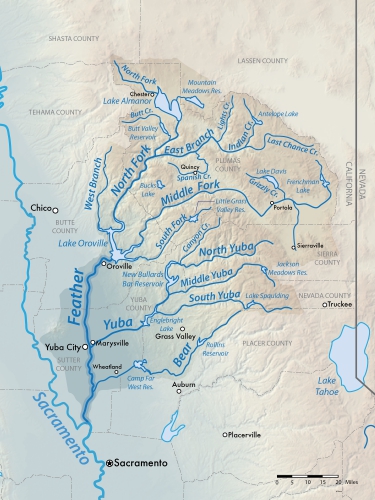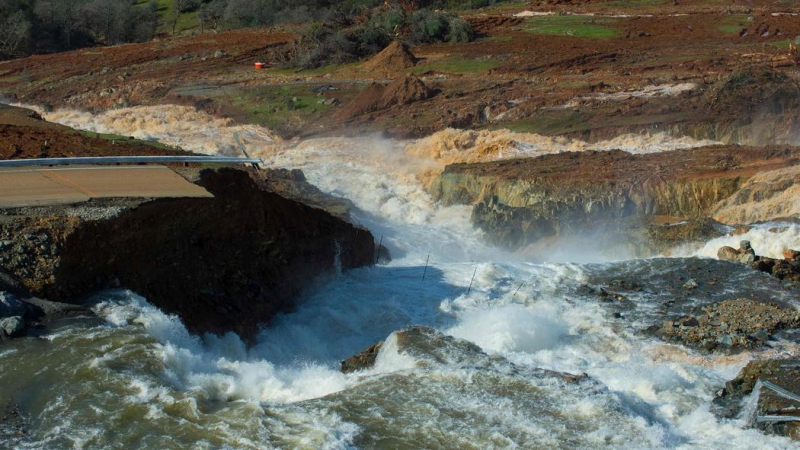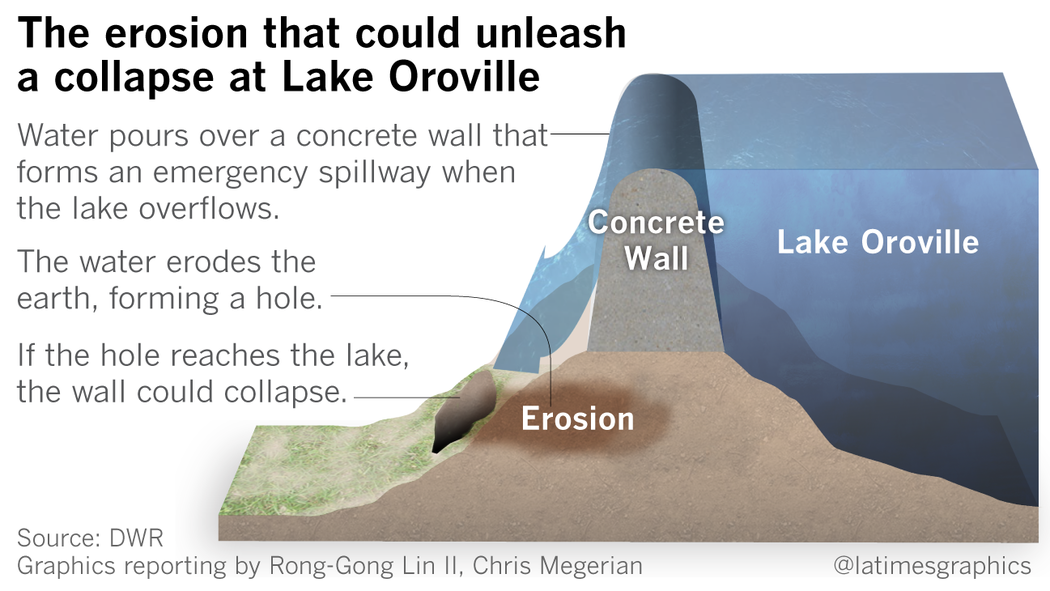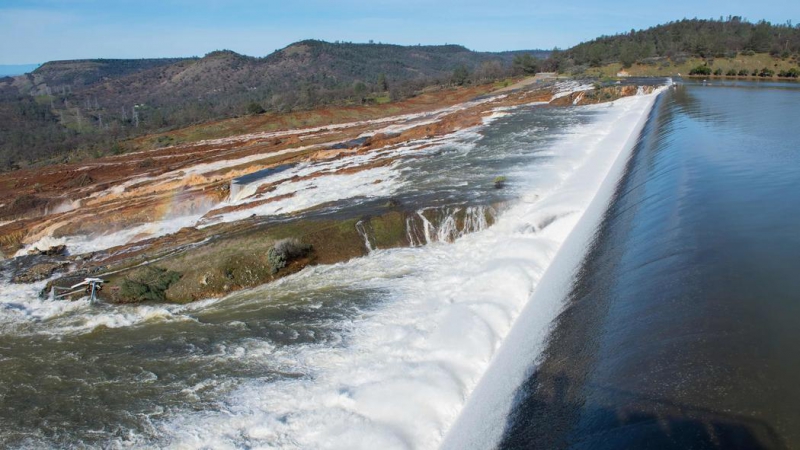From the Open-Publishing Calendar
From the Open-Publishing Newswire
Indybay Feature
Lake Oroville surges over emergency spillway for first time in history
Critics of the Delta Tunnels project said the Oroville Dam spillway rupture shows how basic dam assessments, management plans, and maintenance are being neglected as Governor Jerry Brown constantly promotes the California WaterFix as the "solution” to the state’s water supply and ecosystem problems.
“According to the American Society of Engineers 2013 Report, there are 678 high hazard dams in California, and 48% of them do not have an emergency plan,” said Barbara Barrigan-Parrilla, executive director of Restore the Delta, responding to the Oroville Dam rupture on February 8. “Watching the damage unfold at Oroville, it is striking to us that Governor Brown, CA WaterFix proponents, and Department of Water Resources leaders keep telling Californians that the tunnels are the needed fix for updating California’s water delivery system, yet basic dam assessments, management plans, and maintenance are forgotten or put off."
“The Federal Government had indicated that Oroville Dam needed a further seismic assessment, but the Department of Water Resources stated in 2013 that a seismic assessment of Oroville Dam was not needed. What would happen if an earthquake were to happen near the dam today during this high water event?” she asked.
“According to the American Society of Engineers 2013 Report, there are 678 high hazard dams in California, and 48% of them do not have an emergency plan,” said Barbara Barrigan-Parrilla, executive director of Restore the Delta, responding to the Oroville Dam rupture on February 8. “Watching the damage unfold at Oroville, it is striking to us that Governor Brown, CA WaterFix proponents, and Department of Water Resources leaders keep telling Californians that the tunnels are the needed fix for updating California’s water delivery system, yet basic dam assessments, management plans, and maintenance are forgotten or put off."
“The Federal Government had indicated that Oroville Dam needed a further seismic assessment, but the Department of Water Resources stated in 2013 that a seismic assessment of Oroville Dam was not needed. What would happen if an earthquake were to happen near the dam today during this high water event?” she asked.
Lake Oroville surges over emergency spillway for first time in history
by Dan Bacher
Water from Lake Oroville flowed over the emergency spillway at Oroville Dam for the first time in the reservoir's 48-year history after the water level exceeded 901 feet in elevation shortly after 8 a.m. today.
The water slowly began to flow over the concrete weir of the auxiliary spillway, down a hillside and into the Feather River, a major tributary of the Sacramento River, the state’s largest river.
The flow over the auxiliary spillway has been between 6,000 and 12,000 cubic feet per second (cfs), according to an update from the California Department of Water Resources (DWR) at 10:14 am. on February 11.
Agency officials expect these flows to go into the auxiliary spillway for 32 to 58 hours, based on the latest modeling of weather, reservoir inflow and other factors. There is "no danger to dam or people" from the flows, according to DWR.
In a news briefing today, DWR Acting Director William Croyle said dealing with the damage caused by the growing hole in the dam's primary spillway could cost $100 to $200 million.
Croyle said the damaged spillway will need "complete replacement," noting that the current structure is "toast all the way to the bottom."
“The flows we’re seeing are extremely low compared to the design of the structure,” said Croyle. “Based on our current situation, there is no threat.”
In a statement earlier today, DWR said the volume of water "is expected to pose no flood threat downstream and should remain well within the capacity of the Feather River and other channels to handle. Oroville Dam itself remains safe, and there is no imminent threat to the public."
"The emergency spillway has not been used since the dam was finished in 1968, but DWR has anticipated and prepared for its use since Tuesday, when erosion opened a cavity on the concrete, gated spillway typically used in winter operations at Lake Oroville," the agency said. "DWR continues to use that damaged spillway to discharge 55,000 cubic feet per second, but the approximately 95,000 cfs inflow to the lake exceeds that discharge. As of 4 a.m., the lake level was .7 feet away from the 901 foot elevation at which water flows over a concrete weir and into the unlined emergency spillway."
The agency noted that DWR and CAL FIRE crews in past days have been clearing trees and brush from the path water is expected to take in the emergency spillway, an unlined hillside. The emergency spillway flows are expected to wash large amounts of soil and debris into the Feather River, and crews are positioned to remove as much debris as possible from the channel immediately downstream of the dam.
"The total flow of water from the reservoir, including the emergency spillway, is expected to be on the order of half of downstream flood system capacity and consistent with releases made at this time of year in wet years such as this. While DWR does not expect flows to exceed downstream channel carrying capacity, the rate of flow into the ungated emergency spillway may change quickly," DWR said.
In a tweet this morning, Peter Gleick, President Emeritus and Chief Scientist of the Pacific Institute, pointed out, "Oroville Dam inflow continues to exceed controlled outflow. Reservoir will rise until flow over emergency spillway equals inflow."
Late yesterday afternoon, over 50 staff from the California Department of Fish and Wildlife completed a rescue of 8 million young salmon and 1 million eyed steelhead eggs at the Feather River Fish Hatchery.
Hatchery staff using 8 trucks relocated the 6.5 million fall-run and spring run Chinooks to the hatchery annex near the Thermalito Afterbay, according to Andrew Hughan, CDFW spokesman. These fish, approximately 1 inch long each, would die from suffocation in the turbid, sediment-laden water if left in the raceways of the hatchery.
Approximately 1.5 million juvenile salmon will remain in the hatchery where they will be benefit from sediment ponds set up to cleanse the water. Engineering staff have also set up a charcoal filtration system utilizing a fire hydrant pump for the 1 million eyed steelhead eggs remaining in the hatchery.
“Right now we consider our rescue operation to be a good success,” said Hughan. “We brought in staff from hatcheries all over the state to help in this emergency effort.”
For more information on the fish rescue, go to: http://www.elkgrovenews.net/2017/02/cdfw-rescues-8-million-young-salmon-1.html
Critics of the Delta Tunnels project said the Oroville Dam spillway rupture shows how basic dam assessments, management plans, and maintenance are being neglected as Governor Jerry Brown constantly promotes the California WaterFix as the "solution” to the state’s water supply and ecosystem problems.
“According to the American Society of Engineers 2013 Report, there are 678 high hazard dams in California, and 48% of them do not have an emergency plan,” said Barbara Barrigan-Parrilla, executive director of Restore the Delta, responding to the Oroville Dam rupture on February 8. “Watching the damage unfold at Oroville, it is striking to us that Governor Brown, CA WaterFix proponents, and Department of Water Resources leaders keep telling Californians that the tunnels are the needed fix for updating California’s water delivery system, yet basic dam assessments, management plans, and maintenance are forgotten or put off."
“The Federal Government had indicated that Oroville Dam needed a further seismic assessment, but the Department of Water Resources stated in 2013 that a seismic assessment of Oroville Dam was not needed. What would happen if an earthquake were to happen near the dam today during this high water event?” she asked.
For more information, go to: http://www.dailykos.com/story/2017/2/8/1631621/-Giant-cavity-opens-in-Oroville-Dam-spillway-as-Jerry-Brown-focuses-on-Delta-Tunnels
Lake conditions, including lake levels, inflows, and outflows can be obtained via a recorded message at 530-534-2307. More information is available here at http://cdec.water.ca.gov/cdecapp/resapp/resDetailOrig.action?resid=ORO.
by Dan Bacher
Water from Lake Oroville flowed over the emergency spillway at Oroville Dam for the first time in the reservoir's 48-year history after the water level exceeded 901 feet in elevation shortly after 8 a.m. today.
The water slowly began to flow over the concrete weir of the auxiliary spillway, down a hillside and into the Feather River, a major tributary of the Sacramento River, the state’s largest river.
The flow over the auxiliary spillway has been between 6,000 and 12,000 cubic feet per second (cfs), according to an update from the California Department of Water Resources (DWR) at 10:14 am. on February 11.
Agency officials expect these flows to go into the auxiliary spillway for 32 to 58 hours, based on the latest modeling of weather, reservoir inflow and other factors. There is "no danger to dam or people" from the flows, according to DWR.
In a news briefing today, DWR Acting Director William Croyle said dealing with the damage caused by the growing hole in the dam's primary spillway could cost $100 to $200 million.
Croyle said the damaged spillway will need "complete replacement," noting that the current structure is "toast all the way to the bottom."
“The flows we’re seeing are extremely low compared to the design of the structure,” said Croyle. “Based on our current situation, there is no threat.”
In a statement earlier today, DWR said the volume of water "is expected to pose no flood threat downstream and should remain well within the capacity of the Feather River and other channels to handle. Oroville Dam itself remains safe, and there is no imminent threat to the public."
"The emergency spillway has not been used since the dam was finished in 1968, but DWR has anticipated and prepared for its use since Tuesday, when erosion opened a cavity on the concrete, gated spillway typically used in winter operations at Lake Oroville," the agency said. "DWR continues to use that damaged spillway to discharge 55,000 cubic feet per second, but the approximately 95,000 cfs inflow to the lake exceeds that discharge. As of 4 a.m., the lake level was .7 feet away from the 901 foot elevation at which water flows over a concrete weir and into the unlined emergency spillway."
The agency noted that DWR and CAL FIRE crews in past days have been clearing trees and brush from the path water is expected to take in the emergency spillway, an unlined hillside. The emergency spillway flows are expected to wash large amounts of soil and debris into the Feather River, and crews are positioned to remove as much debris as possible from the channel immediately downstream of the dam.
"The total flow of water from the reservoir, including the emergency spillway, is expected to be on the order of half of downstream flood system capacity and consistent with releases made at this time of year in wet years such as this. While DWR does not expect flows to exceed downstream channel carrying capacity, the rate of flow into the ungated emergency spillway may change quickly," DWR said.
In a tweet this morning, Peter Gleick, President Emeritus and Chief Scientist of the Pacific Institute, pointed out, "Oroville Dam inflow continues to exceed controlled outflow. Reservoir will rise until flow over emergency spillway equals inflow."
Late yesterday afternoon, over 50 staff from the California Department of Fish and Wildlife completed a rescue of 8 million young salmon and 1 million eyed steelhead eggs at the Feather River Fish Hatchery.
Hatchery staff using 8 trucks relocated the 6.5 million fall-run and spring run Chinooks to the hatchery annex near the Thermalito Afterbay, according to Andrew Hughan, CDFW spokesman. These fish, approximately 1 inch long each, would die from suffocation in the turbid, sediment-laden water if left in the raceways of the hatchery.
Approximately 1.5 million juvenile salmon will remain in the hatchery where they will be benefit from sediment ponds set up to cleanse the water. Engineering staff have also set up a charcoal filtration system utilizing a fire hydrant pump for the 1 million eyed steelhead eggs remaining in the hatchery.
“Right now we consider our rescue operation to be a good success,” said Hughan. “We brought in staff from hatcheries all over the state to help in this emergency effort.”
For more information on the fish rescue, go to: http://www.elkgrovenews.net/2017/02/cdfw-rescues-8-million-young-salmon-1.html
Critics of the Delta Tunnels project said the Oroville Dam spillway rupture shows how basic dam assessments, management plans, and maintenance are being neglected as Governor Jerry Brown constantly promotes the California WaterFix as the "solution” to the state’s water supply and ecosystem problems.
“According to the American Society of Engineers 2013 Report, there are 678 high hazard dams in California, and 48% of them do not have an emergency plan,” said Barbara Barrigan-Parrilla, executive director of Restore the Delta, responding to the Oroville Dam rupture on February 8. “Watching the damage unfold at Oroville, it is striking to us that Governor Brown, CA WaterFix proponents, and Department of Water Resources leaders keep telling Californians that the tunnels are the needed fix for updating California’s water delivery system, yet basic dam assessments, management plans, and maintenance are forgotten or put off."
“The Federal Government had indicated that Oroville Dam needed a further seismic assessment, but the Department of Water Resources stated in 2013 that a seismic assessment of Oroville Dam was not needed. What would happen if an earthquake were to happen near the dam today during this high water event?” she asked.
For more information, go to: http://www.dailykos.com/story/2017/2/8/1631621/-Giant-cavity-opens-in-Oroville-Dam-spillway-as-Jerry-Brown-focuses-on-Delta-Tunnels
Lake conditions, including lake levels, inflows, and outflows can be obtained via a recorded message at 530-534-2307. More information is available here at http://cdec.water.ca.gov/cdecapp/resapp/resDetailOrig.action?resid=ORO.
Add Your Comments
Comments
(Hide Comments)
Spillway damaged at Lake Oroville
(Kelly M. Grow / California Department of Water Resources)
Water from the Oroville Dam Auxiliary Spillway at Lake Oroville has eroded the roadway to the spillway boat ramp.
The frantic fight to keep the Oroville Dam crisis from turning into a catastrophe
http://www.latimes.com/local/lanow/la-me-ln-oroville-dam-crisis-20170213-story.html
Threat Eases at Oroville Spillway; Officials Race to Lower Lake as Next Storm Looms
https://ww2.kqed.org/news/2017/02/12/erosion-creates-hole-in-emergency-spillway-at-lake-oroville-threatening-collapse/
Lake Oroville water level declining
http://www.latimes.com/local/california/la-live-updates-oroville-dam-lake-oroville-water-levels-1487012534-htmlstory.html
Series of storms to make trouble for Lake Oroville
http://www.sfgate.com/news/article/Series-of-storms-to-make-trouble-for-Lake-Oroville-10928922.php
(Kelly M. Grow / California Department of Water Resources)
Water from the Oroville Dam Auxiliary Spillway at Lake Oroville has eroded the roadway to the spillway boat ramp.
The frantic fight to keep the Oroville Dam crisis from turning into a catastrophe
http://www.latimes.com/local/lanow/la-me-ln-oroville-dam-crisis-20170213-story.html
Threat Eases at Oroville Spillway; Officials Race to Lower Lake as Next Storm Looms
https://ww2.kqed.org/news/2017/02/12/erosion-creates-hole-in-emergency-spillway-at-lake-oroville-threatening-collapse/
Lake Oroville water level declining
http://www.latimes.com/local/california/la-live-updates-oroville-dam-lake-oroville-water-levels-1487012534-htmlstory.html
Series of storms to make trouble for Lake Oroville
http://www.sfgate.com/news/article/Series-of-storms-to-make-trouble-for-Lake-Oroville-10928922.php
Diagram of Oroville Dam emergency spillway problem (Raoul Rañoa/Los Angeles Times)
Officials had thought things were going fine until suddenly, on Sunday afternoon, authorities were alerted to what they described as erosion developing near the emergency spillway.
The erosion was occurring so fast that officials feared the concrete wall would be undermined, and that it would cause a catastrophic release of water downstream. Officials said they couldn’t wait to act if the worst-case scenario struck, and ordered sweeping evacuations.
The situation has improved. There has been no catastrophic collapse of the concrete wall on top of the emergency spillway, which would have resulted in an overwhelming release of water downstream.
Officials decided to focus their efforts on draining the lake to funneling more water down the main spillway, a concrete slide that is supposed to be the primary way of draining a full Lake Oroville. The main spillway itself was hobbled last week, as parts of it began disintegrating as a giant pothole formed underneath a section.
Authorities knew they had to take pressure off the emergency spillway, so they began sending more water down the main spillway late Sunday. They increased the flow from 55,000 cubic feet per second to 100,000 cubic feet per second, and hoped for the best.
They were in luck on Sunday night. Sunday’s increased flows did not appear to damage the main spillway further. And before midnight, the main spillway had drained the lake enough so that water was no longer flowing down the emergency spillway.
The dry weather early this week helped. As of Sunday night, only 40,000 cubic feet of water per second was flowing into Lake Oroville, and because 100,000 of cubic feet of water per second is flowing out, lake levels are being reduced.
Officials had thought things were going fine until suddenly, on Sunday afternoon, authorities were alerted to what they described as erosion developing near the emergency spillway.
The erosion was occurring so fast that officials feared the concrete wall would be undermined, and that it would cause a catastrophic release of water downstream. Officials said they couldn’t wait to act if the worst-case scenario struck, and ordered sweeping evacuations.
The situation has improved. There has been no catastrophic collapse of the concrete wall on top of the emergency spillway, which would have resulted in an overwhelming release of water downstream.
Officials decided to focus their efforts on draining the lake to funneling more water down the main spillway, a concrete slide that is supposed to be the primary way of draining a full Lake Oroville. The main spillway itself was hobbled last week, as parts of it began disintegrating as a giant pothole formed underneath a section.
Authorities knew they had to take pressure off the emergency spillway, so they began sending more water down the main spillway late Sunday. They increased the flow from 55,000 cubic feet per second to 100,000 cubic feet per second, and hoped for the best.
They were in luck on Sunday night. Sunday’s increased flows did not appear to damage the main spillway further. And before midnight, the main spillway had drained the lake enough so that water was no longer flowing down the emergency spillway.
The dry weather early this week helped. As of Sunday night, only 40,000 cubic feet of water per second was flowing into Lake Oroville, and because 100,000 of cubic feet of water per second is flowing out, lake levels are being reduced.
For more information:
http://www.latimes.com/local/lanow/la-me-l...
Kelly M. Grow / California Department of Water Resources
As we can see from the many pictures on the Internet, the 188,000 evacuees are poor people who have no choice but to sleep in their cars and in temporary shelters for possibly 2.5 months since the rainy season ends May 1, and it is only February 13. They cannot afford a hotel for one night much less 2.5 months. The Oroville Dam provides water for agriculture in much of the State of California, including Tulare County's orange groves. When it comes to fruits and vegetables, California feeds the nation when producing at full capacity. The Democratic-majority Legislature and the Democratic governor are engaged in criminal crisis maintenance instead of taxing the 663,000 millionaire households in California, including 124 billionaires, with an increase in the progressive income tax which would certainly pay for seismic protection and dam maintenance, and much more. The Democrats have dominated the California Legislature for all but 4 years since 1959 and the Governor's office for 25 years since 1959. The Democrats, like the Republicans, are a menace to all our lives, including their own. After all, the Oroville Dam is only 75 miles north of Sacramento, the state capital of 479,000 people and the whole state is earthquake country.
The only two parties that will tax the rich and engage in preventive maintenance of dams and everything else are Peace & Freedom and the Green Party. You can register online at https://covr.sos.ca.gov/?language=en-US
For more information, see:
http://www.peaceandfreedom.org/home/
http://www.peaceandfreedom.org/home/about-us/platform/full-platform
http://www.cagreens.org/
http://www.cagreens.org/platform
http://www.gp.org/
http://www.gp.org/platform
The only two parties that will tax the rich and engage in preventive maintenance of dams and everything else are Peace & Freedom and the Green Party. You can register online at https://covr.sos.ca.gov/?language=en-US
For more information, see:
http://www.peaceandfreedom.org/home/
http://www.peaceandfreedom.org/home/about-us/platform/full-platform
http://www.cagreens.org/
http://www.cagreens.org/platform
http://www.gp.org/
http://www.gp.org/platform
We are 100% volunteer and depend on your participation to sustain our efforts!
Get Involved
If you'd like to help with maintaining or developing the website, contact us.
Publish
Publish your stories and upcoming events on Indybay.
Topics
More
Search Indybay's Archives
Advanced Search
►
▼
IMC Network


